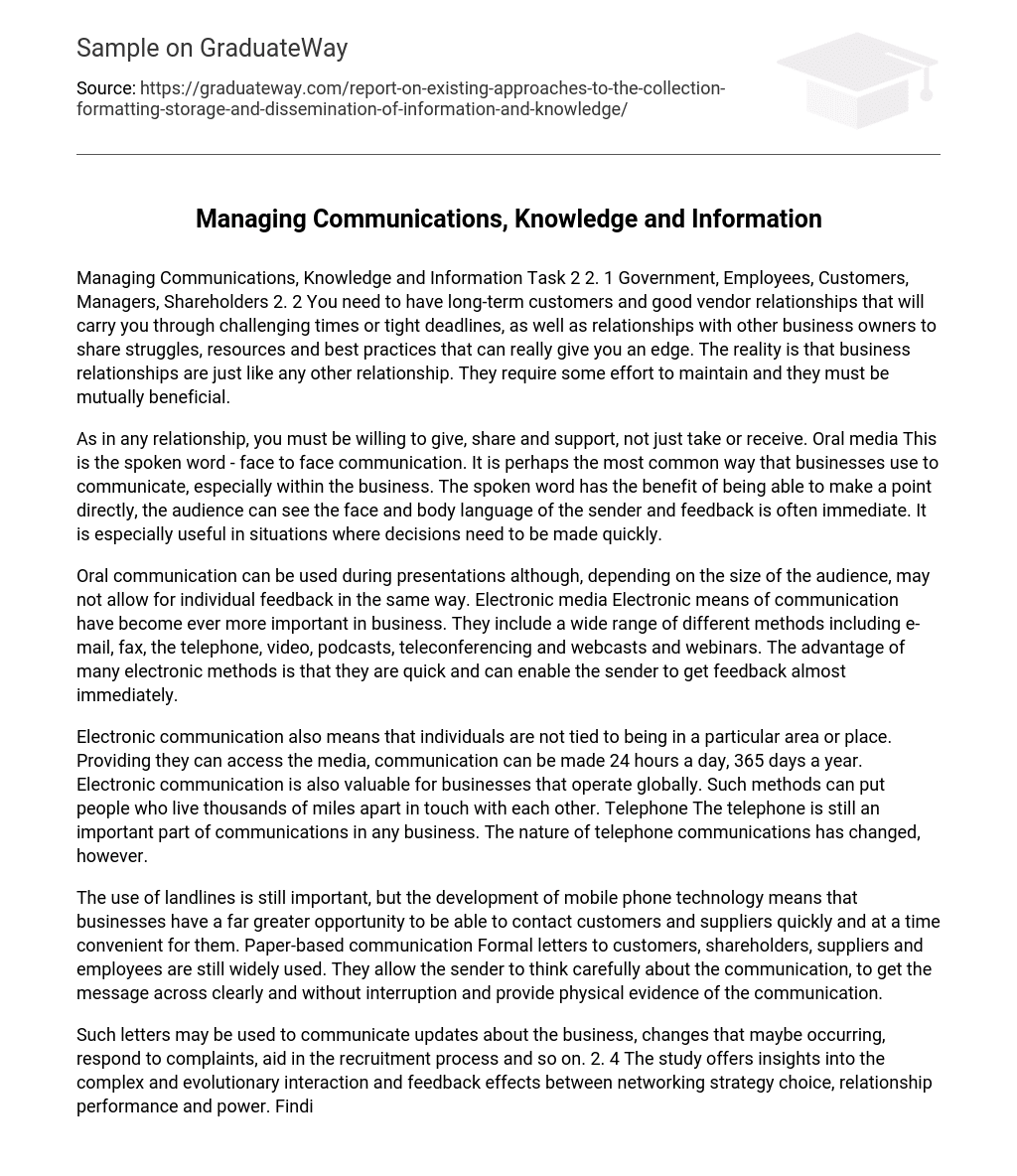You need to have long-term customers and good vendor relationships that will carry you through challenging times or tight deadlines, as well as relationships with other business owners to share struggles, resources and best practices that can really give you an edge. The reality is that business relationships are just like any other relationship. They require some effort to maintain and they must be mutually beneficial.
As in any relationship, you must be willing to give, share and support, not just take or receive.
- Oral media This is the spoken word – face to face communication. It is perhaps the most common way that businesses use to communicate, especially within the business. The spoken word has the benefit of being able to make a point directly, the audience can see the face and body language of the sender and feedback is often immediate. It is especially useful in situations where decisions need to be made quickly. Oral communication can be used during presentations although, depending on the size of the audience, may not allow for individual feedback in the same way.
- Electronic media Electronic means of communication have become ever more important in business. They include a wide range of different methods including e-mail, fax, the telephone, video, podcasts, teleconferencing and webcasts and webinars. The advantage of many electronic methods is that they are quick and can enable the sender to get feedback almost immediately. Electronic communication also means that individuals are not tied to being in a particular area or place. Providing they can access the media, communication can be made 24 hours a day, 365 days a year. Electronic communication is also valuable for businesses that operate globally. Such methods can put people who live thousands of miles apart in touch with each other.
- Telephone The telephone is still an important part of communications in any business. The nature of telephone communications has changed, however. The use of landlines is still important, but the development of mobile phone technology means that businesses have a far greater opportunity to be able to contact customers and suppliers quickly and at a time convenient for them. Paper-based communication Formal letters to customers, shareholders, suppliers and employees are still widely used. They allow the sender to think carefully about the communication, to get the message across clearly and without interruption and provide physical evidence of the communication.
Such letters may be used to communicate updates about the business, changes that maybe occurring, respond to complaints, aid in the recruitment process and so on.
The study offers insights into the complex and evolutionary interaction and feedback effects between networking strategy choice, relationship performance and power. Findings show that although certain strategies may be desirable for firms to manage their business relationships, they are not necessarily as successful in all situations.
Results indicate that a trade-off exists between relationship context and performance which needs to be considered in strategic networking decisions. Further, the study shows that too many strategy changes cause relationships to become unstable and thus negatively affect performance. The authors refer to this phenomenon as strategy volatility — the rate at which actors change their networking strategies within relationships. This phenomenon arises when too many variables influence firms’ decision making and thus cause firms to frequently change their strategy. Although strategy volatility has a relationship safeguarding effect in the short term, this effect diminishes over time.
Before you start implementing changes to improve your business, it’s a good idea to make sure you have a full understanding of the factors impacting on your business success. These factors may include your current business practices, market trends or changes to the wider environment in which you operate. A number of tools can help you assess your business’s situation. These include:
- SWOT analysis – helps you identify your business’s strengths, weaknesses, opportunities and threats.
- Benchmarking – measures your business’s performance against similar-sized businesses in your industry.
- Market research – investigates your business’s market and industry to identify trends, changes and customer or client demands.
- Trend analysis – uses business data collected over time to identify consistent results or trends.
- Webinars (web-based seminars) provide useful information that can help you develop your business skills.
Set clear goals Business goals can be as broad or as specific as you want them to be. Writing down your goals clearly will make it easier for you to achieve them. Make sure your goals are:
- Specific – state clearly what you want to achieve
- Measurable – make sure you can evaluate success
- Achievable – check your objective is something you have the time and resources to meet
- Relevant – make sure your objectives improve profit drivers and improve some part of your business
- Timely – set a specific date for completion.
Once you have written down your goals, you should priorities them to decide which ones to focus on first. Develop a plan for implementing your strategies To achieve your goals, you need to work out how to implement your strategies. Strategies often include several specific actions or tasks.
It’s a good idea to develop a plan for how you will do this. Write a plan in a format that suits. It should include:
- Time frame – how long a task will take to complete as well as start and finish dates
- Actions – state the individual actions as precisely as you can
- Responsibilities – assign accountability for each action so everyone knows precisely what you expect of them and who is responsible for ensuring the work is done
- Resources – list budget, staff or supplies needed to complete each action
- Desired outcome – state how you will know that the action has been completed.





